2016 NISSAN LEAF tow
[x] Cancel search: towPage 392 of 437
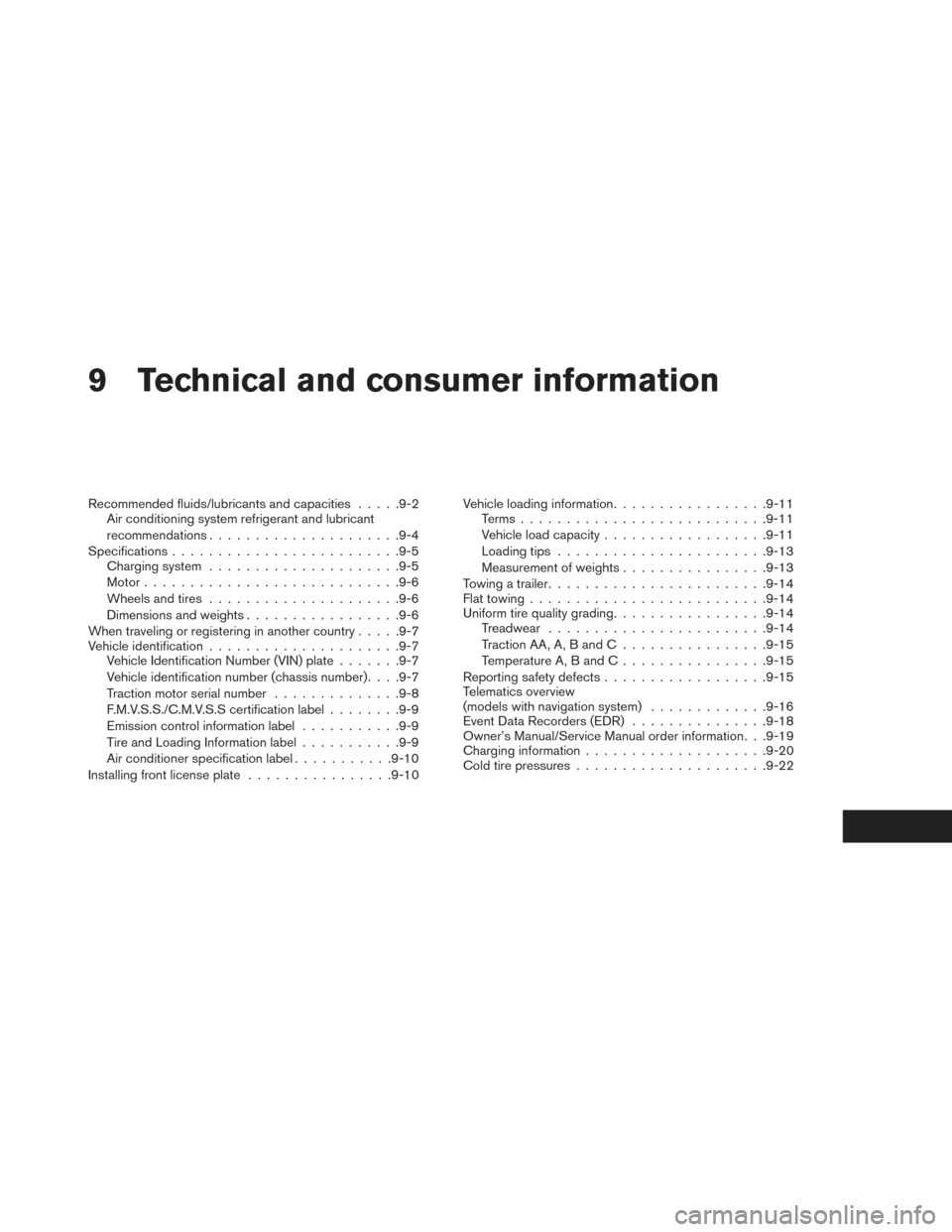
9 Technical and consumer information
Recommended fluids/lubricants and capacities.....9-2
Air conditioning system refrigerant and lubricant
recommendations .................... .9-4
Specifications ........................ .9-5
Charging system .................... .9-5
Motor ........................... .9-6
Wheels and tires .................... .9-6
Dimensions and weights ................ .9-6
When traveling or registering in another country .....9-7
Vehicle identification .................... .9-7
Vehicle Identification Number (VIN) plate .......9-7
Vehicle identification number (chassis number). . . .9-7
Traction motor serial number ..............9-8
F.M.V.S.S./C.M.V.S.S certification label ........9-9
Emission control information label ...........9-9
Tire and Loading Information label ...........9-9
Air conditioner specification label ...........9-10
Installing front license plate ................9-10Vehicle loading information
.................9-11
Terms .......................... .9-11
Vehicle load capacity ................. .9-11
Loading tips ...................... .9-13
Measurement of weights ................9-13
Towing a trailer ....................... .9-14
Flat towing ......................... .9-14
Uniform tire quality grading .................9-14
Treadwear ....................... .9-14
Traction AA, A, B and C ................9-15
Temperature A, B and C ................9-15
Reporting safety defects ................. .9-15
Telematics overview
(models with navigation system) .............9-16
Event Data Recorders (EDR) ...............9-18
Owner’s Manual/Service Manual order information. . .9-19
Charging information ................... .9-20
Cold tire pressures .................... .9-22
Page 402 of 437

WARNING
•
It is extremely dangerous to ride
in the cargo area inside the ve-
hicle. In a collision, people riding
in these areas are more likely to
be seriously injured or killed.
•Do not allow people to ride in any
area of your vehicle that is not
equipped with seats and seat belts.
•Be sure everyone in your vehicle
is in a seat and using a seat belt
properly.
TERMS
It is important to familiarize yourself with
the following terms before loading your
vehicle:
• Curb Weight (actual weight of your ve- hicle) - vehicle weight including: stan-
dard and optional equipment, fluids,
emergency tools, and spare tire assem-
bly. This weight does not
include passen-
gers and cargo.
• GVW (Gross Vehicle Weight) - curb weight plus the combined weight of pas-
sengers and cargo.
• GVWR (Gross Vehicle Weight Rating) - maximum total combined weight of the
unloaded vehicle, passengers, luggage,
hitch, trailer tongue load and any other
optional equipment. This information is
located on the F.M.V.S.S./C.M.V.S.S.
label.
• GAWR (Gross Axle Weight Rating) - maximum weight (load) limit specified
for the front or rear axle.
• This information is located on the F.M.V.S.S./
C.M.V.S.S. label.
• GCWR (Gross Combined Weight Rat-ing) - The maximum total weight rating of
the vehicle, passengers, cargo, and
trailer.
• Vehicle Capacity Weight, Load limit, To- tal load capacity - maximum total weight
limit specified of the load (passengers
and cargo) for the vehicle. This is the
maximum combined weight of occu- pants and cargo that can be loaded into
the vehicle. If the vehicle is used to tow a
trailer, the trailer tongue weight must be
included as part of the cargo load. This
information is located on the Tire and
Loading Information label.
• Cargo capacity - permissible weight of cargo, the subtracted weight of occu-
pants from the load limit.
VEHICLE LOAD CAPACITY
Do not exceed the load limit of your ve-
hicle shown as “The combined weight of
occupants and cargo” on the Tire and
Loading Information label. Do not exceed
the number of occupants shown as
“Seating Capacity” on the Tire and Load-
ing Information label.
To get “the combined weight of occu-
pants and cargo”, add the weight of all
occupants, then add the total luggage
weight. Examples are shown in the follow-
ing illustration.
VEHICLE LOADING INFORMATION
Technical and consumer information9-11
Page 405 of 437

Do not tow a trailer with your vehicle.Towing your vehicle with all four wheels on the
ground is sometimes called flat towing. This
method is typically used when towing a vehicle
behind a recreational vehicle, such as a motor
home.
CAUTION
• Failure to follow these guidelines can result in severe transmission damage.
• Whenever flat towing your vehicle, al- ways tow forward, never backward.
• Never tow your front wheel drive ve- hicle with the front tires on the ground.
Doing so may cause serious and ex-
pensive damage to the powertrain.
• DO NOT tow your front wheel drive continuously variable transmission ve-
hicle with all four wheels on the
ground (flat towing) . Doing so WILL
DAMAGE internal transmission parts
due to lack of transmission lubrication.
• For emergency towing procedures re- fer to “Towing recommended by
NISSAN” in the “In case of emergency”
section of this manual. DOT (Department Of Transportation) Quality
Grades: All passenger car tires must conform to
federal safety requirements in addition to these
grades.
Quality grades can be found where applicable on
the tire sidewall between tread shoulder and
maximum section width. For example:
Treadwear 200 Traction AA Temperature A
TREADWEAR
The treadwear grade is a comparative rating
based on the wear rate of the tire when tested
under controlled conditions on a specified gov-
ernment test course. For example, a tire graded
150 would wear one and one-half (1 1/2) times
as well on the government course as a tire graded
100. The relative performance of tires depends
upon actual conditions of their use however, and
may depart significantly from the norm due to
variations in driving habits, service practices and
differences in road characteristics and climate.
TOWING A TRAILER
FLAT TOWINGUNIFORM TIRE QUALITY GRADING
9-14Technical and consumer information
Page 415 of 437
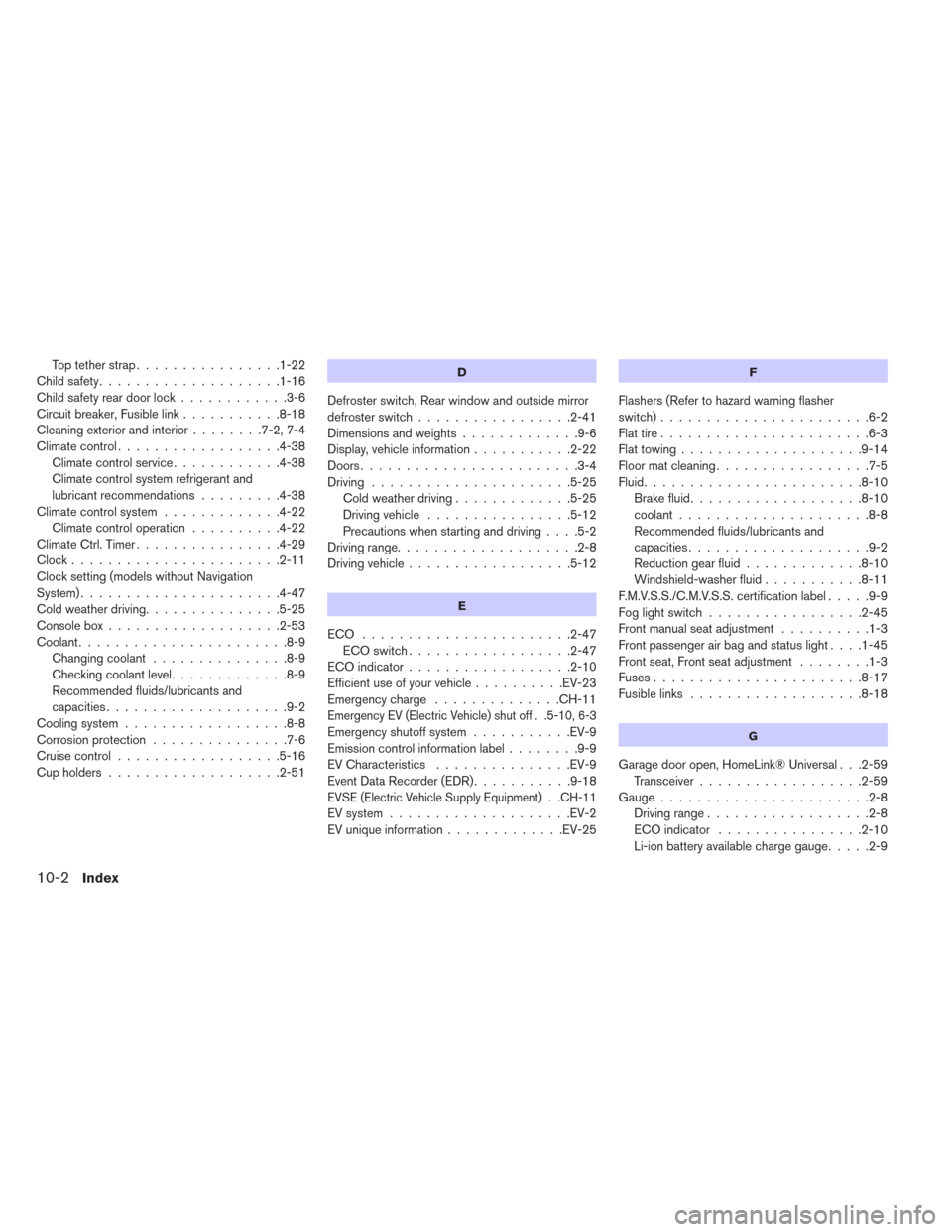
Top tether strap................1-22
Childsafety....................1-16
Child safety rear door lock ............3-6
Circuit breaker, Fusible link ...........8-18
Cleaning exterior and interior ........7-2,7-4
Climatecontrol..................4-38 Climate control service ............4-38
Climate control system refrigerant and
lubricant recommendations .........4-38
Climate control system .............4-22
Climate control operation ..........4-22
Climate Ctrl. Timer ................4-29
Clock.......................2-11
Clock setting (models without Navigation
System) ......................4-47
Cold weather driving ...............5-25
Consolebox...................2-53
Coolant.......................8-9 Changingcoolant ...............8-9
Checkingcoolantlevel.............8-9
Recommended fluids/lubricants and
capacities ....................9-2
Cooling system ..................8-8
Corrosionprotection ...............7-6
Cruisecontrol..................5-16
Cupholders...................2-51D
Defroster switch, Rear window and outside mirror
defroster switch .................2-41
Dimensionsandweights.............9-6
Display, vehicle information ...........2-22
Doors ........................3-4
Driving ......................5-25
Cold weather driving .............5-25
Driving vehicle ................5-12
Precautions when starting and driving ....5-2
Driving range ....................2-8
Driving vehicle ..................5-12
E
ECO .......................2-47
ECO switch ..................2-47
ECOindicator..................2-10
Efficient use of your vehicle ..........EV-23
Emergency charge ..............CH-11
Emergency EV (Electric Vehicle) shut off . .5-10, 6-3
Emergency shutoff system ...........EV-9
Emission control information label ........9-9
EV Characteristics ...............EV-9
Event Data Recorder (EDR) ...........9-18
EVSE (Electric Vehicle Supply Equipment) . .CH-11
EV system....................EV-2
EV unique information .............EV-25
F
Flashers (Refer to hazard warning flasher
switch).......................6-2
Flat tire .......................6-3
Flattowing....................9-14
Floormatcleaning.................7-5
Fluid ........................8-10
Brake fluid ...................8-10
coolant.....................8-8
Recommended fluids/lubricants and
capacities ....................9-2
Reduction gear fluid .............8-10
Windshield-washer fluid ...........8-11
F.M.V.S.S./C.M.V.S.S. certification label .....9-9
Foglightswitch .................2-45
Frontmanualseatadjustment ..........1-3
Front passenger air bag and status light ....1-45
Front seat, Front seat adjustment ........1-3
Fuses.......................8-17
Fusiblelinks ...................8-18
G
Garage door open, HomeLink® Universal . . .2-59 Transceiver ..................2-59
Gauge.......................2-8 Driving range ..................2-8
ECO indicator ................2-10
Li-ion battery available charge gauge .....2-9
10-2Index
Page 418 of 437
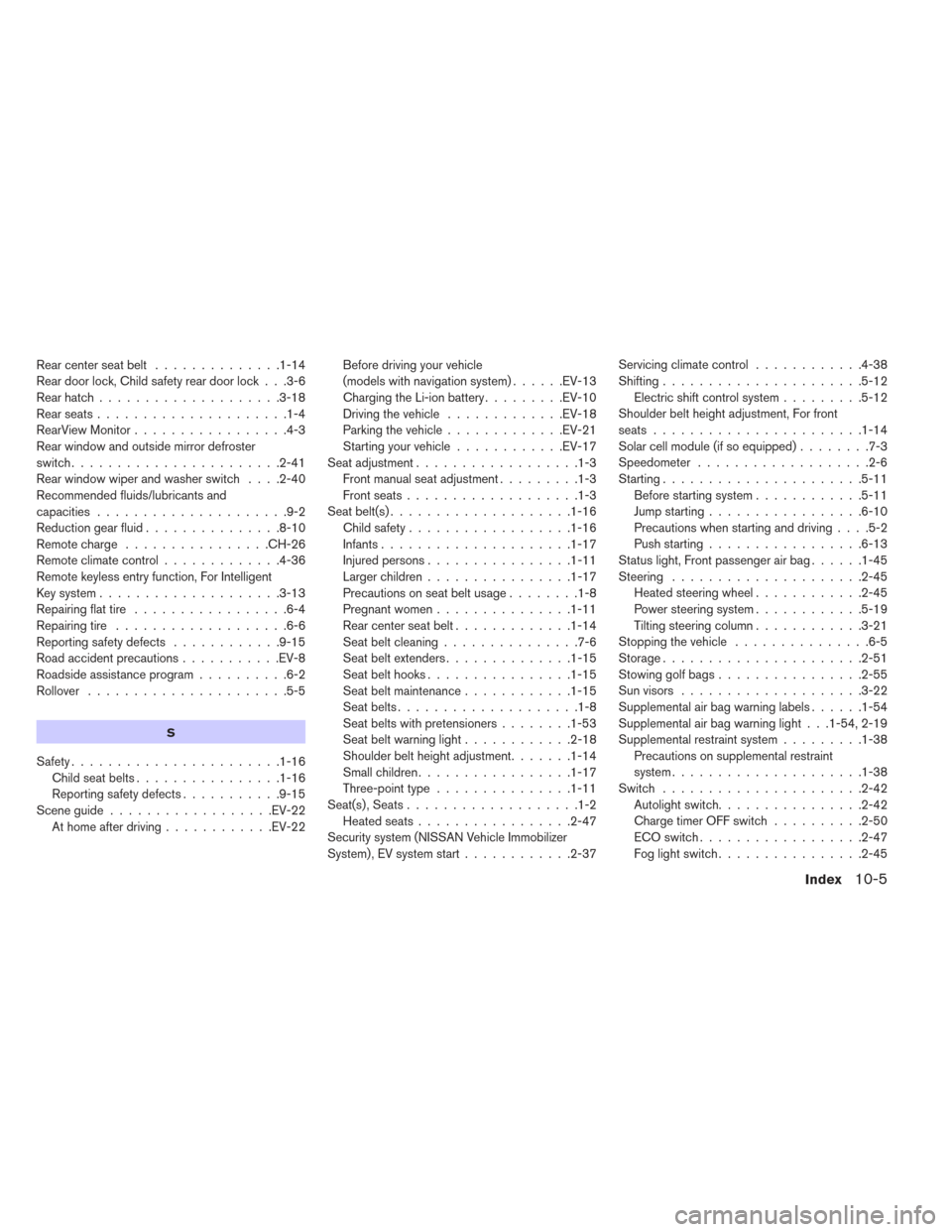
Rearcenterseatbelt ..............1-14
Rear door lock, Child safety rear door lock . . .3-6
Rear hatch....................3-18
Rearseats.....................1-4
RearView Monitor .................4-3
Rear window and outside mirror defroster
switch .......................2-41
Rear window wiper and washer switch ....2-40
Recommended fluids/lubricants and
capacities .....................9-2
Reductiongearfluid...............8-10
Remotecharge ................CH-26
Remoteclimatecontrol.............4-36
Remote keyless entry function, For Intelligent
Keysystem....................3-13
Repairing flat tire .................6-4
Repairing tire ...................6-6
Reporting safety defects ............9-15
Road accident precautions ...........EV-8
Roadside assistance program ..........6-2
Rollover ......................5-5
S
Safety .......................1-16
Childseatbelts................1-16
Reporting safety defects ...........9-15
Sceneguide..................EV-22 At home after driving ............EV-22 Before driving your vehicle
(models with navigation system)
......EV-13
Charging the Li-ion battery .........EV-10
Driving the vehicle .............EV-18
Parking the vehicle .............EV-21
Starting your vehicle ............EV-17
Seat adjustment ..................1-3
Front manual seat adjustment .........1-3
Frontseats...................1-3
Seat belt(s) ....................1-16
Child safety ..................1-16
Infants.....................1-17
Injuredpersons................1-11
Largerchildren................1-17
Precautions on seat belt usage ........1-8
Pregnant women ...............1-11
Rear center seat belt .............1-14
Seatbeltcleaning...............7-6
Seatbeltextenders..............1-15
Seat belt hooks ................1-15
Seat belt maintenance ............1-15
Seatbelts....................1-8
Seat belts with pretensioners ........1-53
Seatbeltwarninglight............2-18
Shoulder belt height adjustment .......1-14
Smallchildren.................1-17
Three-point type ...............1-11
Seat(s) , Seats ...................1-2
Heatedseats.................2-47
Security system (NISSAN Vehicle Immobilizer
System) , EV system start ............2-37 Servicing climate control
............4-38
Shifting ......................5-12
Electric shift control system .........5-12
Shoulder belt height adjustment, For front
seats .......................1-14
Solar cell module (if so equipped) ........7-3
Speedometer ...................2-6
Starting ......................5-11
Before starting system ............5-11
Jump starting .................6-10
Precautions when starting and driving ....5-2
Push starting .................6-13
Status light, Front passenger air bag ......1-45
Steering .....................2-45 Heated steering wheel ............2-45
Power steering system ............5-19
Tilting steering column ............3-21
Stopping the vehicle ...............6-5
Storage......................2-51
Stowing golf bags ................2-55
Sun visors ....................3-22
Supplemental air bag warning labels ......1-54
Supplemental air bag warning light . . .1-54, 2-19
Supplemental restraint system .........1-38
Precautions on supplemental restraint
system .....................1-38
Switch ......................2-42 Autolight switch ................2-42
Charge timer OFF switch ..........2-50
ECO switch ..................2-47
Fog light switch ................2-45
Index10-5
Page 419 of 437
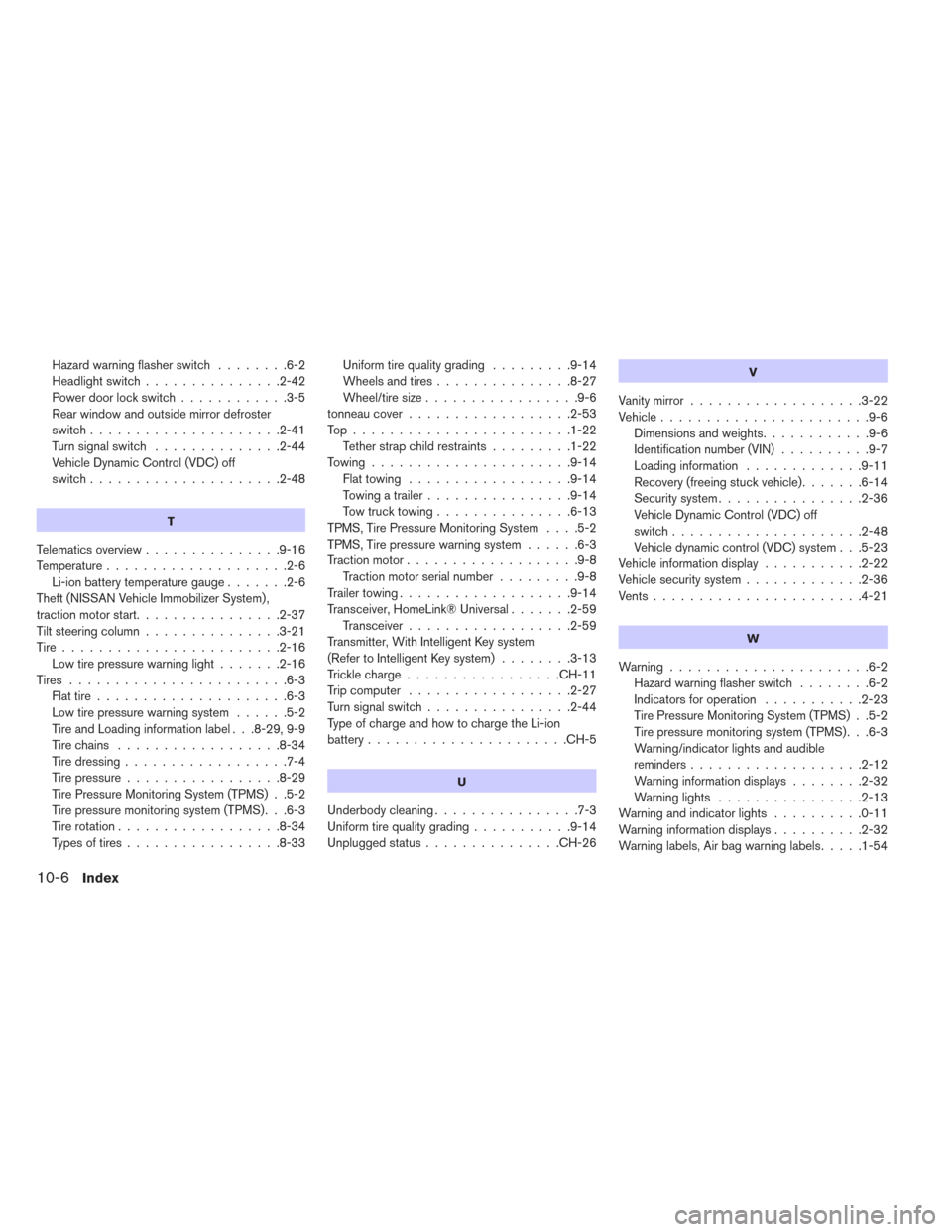
Hazard warning flasher switch........6-2
Headlightswitch...............2-42
Power door lock switch ............3-5
Rear window and outside mirror defroster
switch.....................2-41
Turnsignalswitch ..............2-44
Vehicle Dynamic Control (VDC) off
switch.....................2-48
T
Telematics overview ...............9-16
Temperature ....................2-6
Li-ion battery temperature gauge .......2-6
Theft (NISSAN Vehicle Immobilizer System) ,
traction motor start ................2-37
Tilt steering column ...............3-21
Tire........................2-16 Low tire pressure warning light .......2-16
Tires ........................6-3 Flat tire .....................6-3
Low tire pressure warning system ......5-2
Tire and Loading information label . . .8-29, 9-9
Tire chains ..................8-34
Tire dressing ..................7-4
Tirepressure.................8-29
Tire Pressure Monitoring System (TPMS) . .5-2
Tire pressure monitoring system (TPMS). . .6-3
Tirerotation..................8-34
Types of tires .................8-33 Uniform tire quality grading
.........9-14
Wheels and tires ...............8-27
Wheel/tire size .................9-6
tonneaucover..................2-53
Top........................1-22 Tether strap child restraints .........1-22
Towing......................9-14 Flattowing ..................9-14
Towing a trailer ................9-14
Towtrucktowing...............6-13
TPMS, Tire Pressure Monitoring System ....5-2
TPMS, Tire pressure warning system ......6-3
Tractionmotor...................9-8 Traction motor serial number .........9-8
Trailer towing ...................9-14
Transceiver, HomeLink® Universal .......2-59
Transceiver ..................2-59
Transmitter, With Intelligent Key system
(Refer to Intelligent Key system) ........3-13
Tricklecharge.................CH-11
Trip computer ..................2-27
Turn signal switch ................2-44
Type of charge and how to charge the Li-ion
battery ......................CH-5
U
Underbody cleaning ................7-3
Uniform tire quality grading ...........9-14
Unplugged status ...............CH-26
V
Vanity mirror...................3-22
Vehicle.......................9-6 Dimensionsandweights............9-6
Identification number (VIN) ..........9-7
Loading information .............9-11
Recovery (freeing stuck vehicle) .......6-14
Security system ................2-36
Vehicle Dynamic Control (VDC) off
switch.....................2-48
Vehicle dynamic control (VDC) system . . .5-23
Vehicle information display ...........2-22
Vehicle security system .............2-36
Vents.......................4-21
W
Warning......................6-2 Hazard warning flasher switch ........6-2
Indicators for operation ...........2-23
Tire Pressure Monitoring System (TPMS) . .5-2
Tire pressure monitoring system (TPMS). . .6-3
Warning/indicator lights and audible
reminders...................2-12
Warning information displays ........2-32
Warning lights ................2-13
Warning and indicator lights ..........0-11
Warning information displays ..........2-32
Warning labels, Air bag warning labels .....1-54
10-6Index
Page 436 of 437
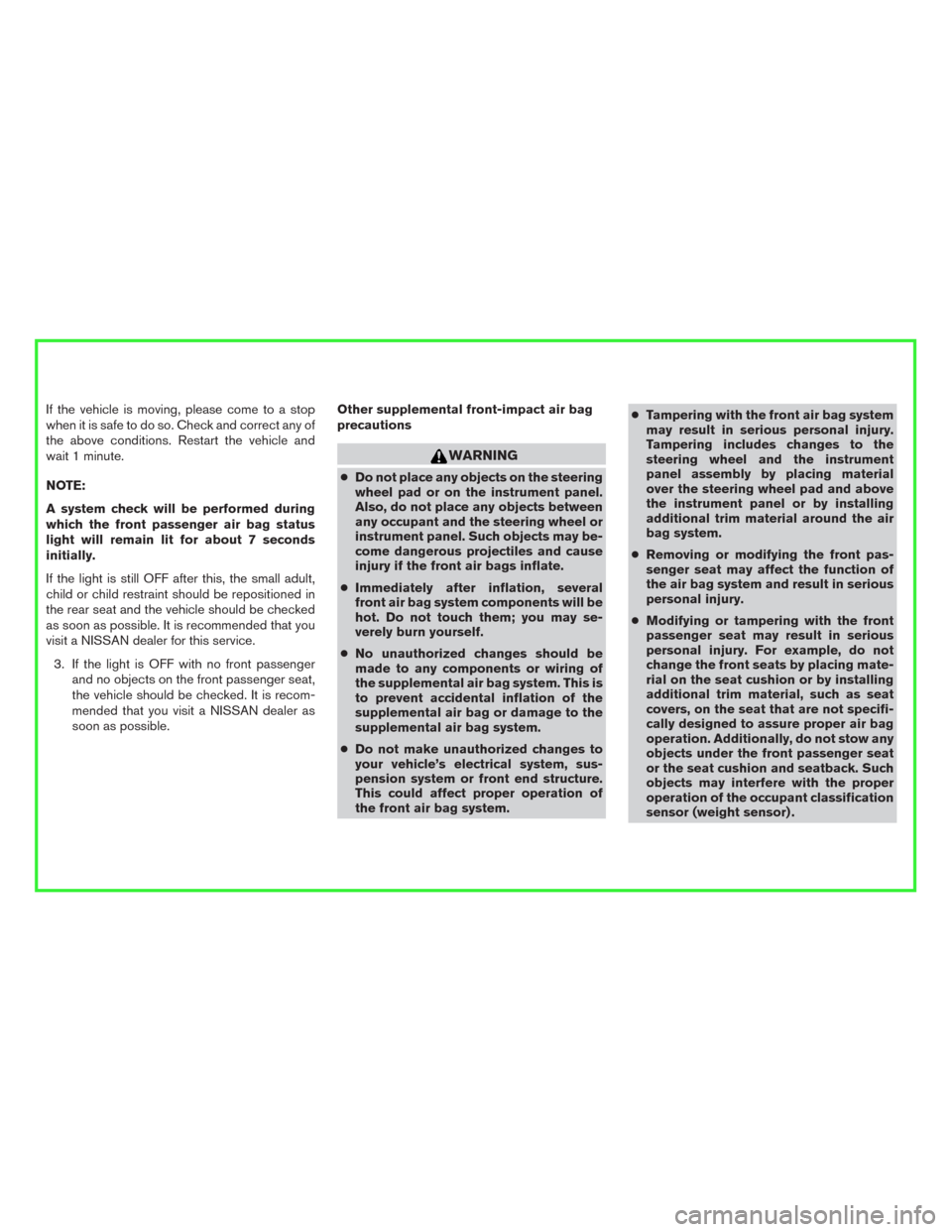
If the vehicle is moving, please come to a stop
when it is safe to do so. Check and correct any of
the above conditions. Restart the vehicle and
wait 1 minute.
NOTE:
A system check will be performed during
which the front passenger air bag status
light will remain lit for about 7 seconds
initially.
If the light is still OFF after this, the small adult,
child or child restraint should be repositioned in
the rear seat and the vehicle should be checked
as soon as possible. It is recommended that you
visit a NISSAN dealer for this service.
3. If the light is OFF with no front passenger
and no objects on the front passenger seat,
the vehicle should be checked. It is recom-
mended that you visit a NISSAN dealer as
soon as possible.Other supplemental front-impact air bag
precautions
WARNING
●Do not place any objects on the steering
wheel pad or on the instrument panel.
Also, do not place any objects between
any occupant and the steering wheel or
instrument panel. Such objects may be-
come dangerous projectiles and cause
injury if the front air bags inflate.
●Immediately after inflation, several
front air bag system components will be
hot. Do not touch them; you may se-
verely burn yourself.
●No unauthorized changes should be
made to any components or wiring of
the supplemental air bag system. This is
to prevent accidental inflation of the
supplemental air bag or damage to the
supplemental air bag system.
●Do not make unauthorized changes to
your vehicle’s electrical system, sus-
pension system or front end structure.
This could affect proper operation of
the front air bag system.●Tampering with the front air bag system
may result in serious personal injury.
Tampering includes changes to the
steering wheel and the instrument
panel assembly by placing material
over the steering wheel pad and above
the instrument panel or by installing
additional trim material around the air
bag system.
●Removing or modifying the front pas-
senger seat may affect the function of
the air bag system and result in serious
personal injury.
●Modifying or tampering with the front
passenger seat may result in serious
personal injury. For example, do not
change the front seats by placing mate-
rial on the seat cushion or by installing
additional trim material, such as seat
covers, on the seat that are not specifi-
cally designed to assure proper air bag
operation. Additionally, do not stow any
objects under the front passenger seat
or the seat cushion and seatback. Such
objects may interfere with the proper
operation of the occupant classification
sensor (weight sensor) .